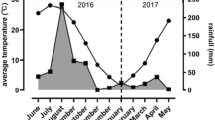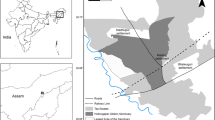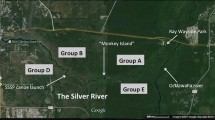Abstract
“Gleaning” is a behaviour observed in feeding associations between arboreal and ground-dwelling animals, wherein the former drop plant items that the latter consume. However, it is not well known whether gleaning is in fact beneficial for the ground-dwelling animals. We observed the gleaning association between sika deer,Cervus nippon Temminck, 1838, and Japanese macaques,Macaca fuscata Blyth, 1875, for 6 years (May 2000 to December 2005) on Kinkazan Island, northern Japan. The gleaning occurred most frequently in spring (from March to May, 28 events), followed by fall (from September to November, 15 events). Gleaning frequency seemed to be affected by both food shortage and nutritional requirement of the deer. Nutritional values of “gleaning foods” dropped by the macaques were higher than those of other non-gleaning foods. These results suggest that the gleaning association with macaques is beneficial to the deer.
Similar content being viewed by others
References
Agetsuma N., Sugiura H., Hill D. A., Agetsuma-Yanagihara Y. and Tanaka T. 2003. Population density and group composition of Japanese sika deer (Cervus nippon yakushimae) in an evergreen broad-leaved forest in Yakushima, southern Japan. Ecological Research 18: 475–483.
Agoramoorthy G. 1997. Apparent feeding associations betweenAlouatta seniculus andOdocoileus virginianus in Venezuela. Mammalia 61: 271–273.
Asada M. and Ochiai K. 1996. Food habits of sika deer on the Boso Peninsula, central Japan. Ecological Research 11: 89–95.
Boinski S. and Scott P. E. 1988. Association of birds with monkeys in Costa-Rica. Biotropica 20: 136–143.
Bräger S. 1998. Feeding associations between white-fronted terns and Hector’s dolphins in New Zealand. Condor 100: 560–562.
Elder W. H. and Elder N. L. 1970. Social groupings and primate associations of the bushbuck (Tragelaphus scriptus). Mammalia 34: 356–362.
Glander K. E. 1979. Feeding associations between howling monkeys and basilisk lizards. Biotropica 11: 235–236.
Goering H. K. and van Soest P. J. 1970. Forage fiber analyses. United States Department of Agriculture. Agricultural Handbook No. 379, Washington D.C.: 1–20.
Ikeda S. and Takatsuki S. 1999. [Seasonal changes in nutritive compositions of the major food plants of sika deer (Cervus nippon) and Japanese serow (Capricornis crispus) — a case study of the Sendai area]. Tohoku Journal of Animal Science and Technology 49: 1–8. [In Japanese]
Ito T. Y. 2000. A study on the short-grass community maintained by grazing of the sika deer on Kinkazan Island. PhD thesis, Tohoku University, Sendai: 1–123.
Ito T. Y. and Takatsuki S. 2005. Relationship between a high density of sika deer and productivity of the short-grass (Zoysia japonica) community: a case study on Kinkazan Island, northern Japan. Ecological Research 20: 573–579.
Majolo B. and Ventura R. 2004. Apparent feeding association between Japanese macaques (Macaca fuscata yakui) and sika deer (Cervus nippon) living on Yakushima Island, Japan. Ethology Ecology and Evolution 16: 33–40.
Maruhashi T., Saito C. and Agetsuma N. 1998. Home range structure and inter-group competition for land of Japanese macaques in evergreen and deciduous forests. Primates 39: 291–301.
Maynard L. A., Loosli J. K., Hinttz H. F. and Warner R. G. 1979. Animal nutrition, 7th ed. McGraw-Hill, New York: 1–613.
Minta S. C., Minta K. A. and Lott D. F. 1992. Hunting associations between badgers (Taxidea taxus) and coyotes (Canis latrans). Journal of Mammalogy 73: 814–820.
Morgan-Davies. 1960. The association between impala and olive baboon. Journal of East African Natural History Society 23: 297–298.
Nakagawa N. 1994. [Various viewpoints of feeding ecology on Japanese monkeys]. Saru no syokutaku. Heibonsya, Tokyo: 1–285. [In Japanese]
Newton P. N. 1985. A note on golden jackals (Canis aureus) and their relationships with langurs (Presbytes entellus) in Kanha Tiger Reserve. Journal of Bombay Natural History Society 82: 633–635.
Newton P. N. 1989. Associations between langur monkeys (Presbytis entellus) and chital deer (Axis axis) — chance encounters or a mutualism? Ethology 83: 89–120.
Padmalal U. and Takatsuki S. 1994. Age-sex differences in the diets of Sika deer on Kinkazan Island, northern Japan. Ecological Research 9: 251–256.
Senzota R. B. M. 1983. A baboon — hyrax feeding facilitation. Mammalia 47: 422–423.
Stensland E., Angerbjorn A. and Berggren P. 2003. Mixed species groups in mammals. Mammal Review 33: 205–223.
Sugiura H., Saito C., Sato S., Agetsuma N., Takahashi H., Tanaka T., Furuichi T. and Takahata Y. 2000. Variation in intergroup encounters in two populations of Japanese macaques. International Journal of Primatology 21: 519–535.
Takahashi H. and Kaji K. 2001. Fallen leaves and unpalatable plants as alternative foods for sika deer under food limitation. Ecological Research 16: 257–262.
Takatsuki S. 1980. Food habits of sika deer on Kinkazan Island. Scientific Report of Tohoku University 38: 7–31.
Takatsuki S. 1983. Group size of sika deer in relation to habitat type on Kinkazan Island. Japanese Journal of Ecology 33: 419–425.
Takatsuki S., Suzuki K. and Suzuki I. 1994. A mass mortality of sika deer on Kinkazan Island, northern Japan. Ecological Research 9: 215–223.
Takatsuki S. 2006. [Ecological history of sika deer]. University of Tokyo Press, Tokyo: 1–480. [In Japanese]
Weerasinghe U. R. and Takatsuki S. 1999. A record of acorn eating by sika deer in western Japan. Ecological Research 14: 205–209.
Yokoyama M., Kaji K. and Suzuki M. 2000. Food habits of sika deer and nutritional value of sika deer diets in eastern Hokkaido, Japan. Ecological Research 15: 345–355.
Yokoyama M., Onuma M., Suzuki M. and Kaji K. 2001. Seasonal fluctuations of body condition in northern sika deer on Hokkaido Island, Japan. Acta Theriologica 46: 419–428.
Yoshii Y. and Yoshioka K. 1949. [Plant communities on Kinkazan Island]. Ecological Review 12: 84–105. [In Japanese]
Author information
Authors and Affiliations
Corresponding author
Additional information
Associate editor was Krzysztof Schmidt.
Rights and permissions
About this article
Cite this article
Tsuji, Y., Shimoda-Ishiguro, M., Ohnishi, N. et al. A friend in need is a friend indeed: feeding association between Japanese macaques and sika deer. Acta Theriol 52, 427–434 (2007). https://doi.org/10.1007/BF03194240
Received:
Accepted:
Issue Date:
DOI: https://doi.org/10.1007/BF03194240




